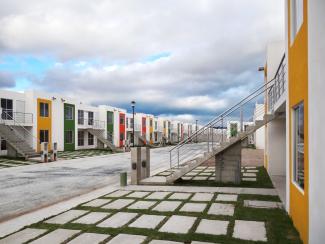Energy efficiency
Climate targets require energy-efficient buildings

The UN Climate Change Secretariat is calling for a “Race to Zero” – reducing emissions of climate-damaging greenhouse gases to zero by 2050. The race is against emissions, but also against time.
Reducing energy consumption in the building sector can play a key part in succeeding. Unfortunately the efforts made so far to cut energy use – the main source of carbon emissions – have not shown results. On the contrary: in the building sector, energy consumption continues to rise.
According to the International Energy Agency, one reason is increased use of electrical appliances. While appliances are becoming more efficient, increased use more than cancels out the efficiency gains. Consider the sharp increase in demand for cooling in buildings. Since 1990, annual sales of air conditioners have quadrupled to 135 million units worldwide, and the trend continues upward. Some 1.6 billion units, half of them in the US and China alone, consume 2,000 terawatt hours of electricity each year. That is 2.5 times the annual electricity consumption of the entire African continent.
Another factor is demographic change: in 2050, around 9.7 billion people will populate the earth, about 2 billion more people than today. They will all need space to live, work and play, causing a disproportionate growth in demand for buildings. Between 2010 and 2018 the world’s population grew by just under 10 %, but building space increased by over 20 %. The additional building space created currently amounts to constructing another Paris every five days.
The longevity of buildings creates enormous challenges, but also opportunities. Half of all the buildings that will exist in 2060 have not yet been built. What we do – or fail to do – today will have an impact on energy use and emissions decades from now. We must act with foresight when planning and building today.
Range of activities
That applies to a wide range of activities. In a joint roadmap to 2050, the International Energy Agency and the Global Alliance for Buildings and Construction, which emerged from the Paris climate summit in 2015, focus on eight areas of activity that should include energy efficiency planning:
- urban planning,
- new buildings,
- renovation of existing buildings,
- building management,
- efficient systems,
- sustainable building materials,
- climate resilience and
- clean energy.
This wide-ranging list shows that measures such as installing insulation or multiple glazing – which are often seen as the centrepiece of energy efficiency – are only cogs in a larger wheel. In fact, energy efficiency and sustainability should be factored into all decisions related to construction and renovation. Humankind needs an adequate standard, for example when drawing up building codes, setting national climate protection targets or reimbursing costs incurred to improve energy efficiency. We also need a faster rate of retrofitting buildings. The application of new technologies and use of sustainable building materials are imperative too, to name just a few important issues.
Acting on behalf of Germany’s Federal Government, KfW Development Bank is supporting partners in the construction sector in the “Race to Zero”. KfW’s initiatives vary significantly, depending on the partner country, local opportunities and overall conditions. On the other hand, KfW can sometimes contribute to shaping the policy context. One example is Georgia. With substantial financial investment and the experience of many years of successful cooperation, KfW and Georgia have jointly developed high energy efficiency standards that are now implemented in public buildings.
In India, KfW construction-specific financing is based on standards that the country previously developed with support from Germany’s GIZ. KfW’s partner is the State Bank of India, the country’s largest bank. KfW provides grants for construction measures that reduce energy demand by 40 % compared to conventional technologies. These grants ensure the economic viability of energy-saving measures and provide incentives for widespread implementation. This is very important, as India is number three in the world in terms of energy consumption in the building sector.
Flagship projects in Montenegro
In Montenegro, KfW is developing a project for a “nearly zero energy building” as part of the country’s national energy-efficiency programme. Reasons for offering support included the country’s proximity to the European Union, its high energy costs and its backlog of renewable energy and building refurbishment projects. Montenegro’s EU accession agreement requires the country to modernise an annual one percent of the total state-owned building stock according to efficiency standards. To help Montenegro achieve this goal, KfW will provide subsidised loans to buy modern energy management systems for the country’s 2,500 public buildings.
Thanks to up-to-date sensor and measurement technology, smart electricity metering can automatically monitor the consumption every 15 minutes. It is thus possible to identify major consumers and to save both energy and water. Worldwide experience shows that such systems can reduce energy use by up to 20 %. The city of Frankfurt, where KfW has its headquarters, was the model for Montenegro’s new system.
Apart from cutting buildings’ energy use, countries should focus on the sustainability of buildings throughout their lifecycle. Even the most energy-efficient buildings have roofs and walls whose production involves CO2 emissions. The way to eliminate carbon footprints eventually is to use sustainable and locally sourced building materials. KfW promotes that approach. It also promotes the use of solar and photovoltaic roof systems – for example as part of Mexico’s “EcoCasa” project (see box).
Sanna Stockstrom is a portfolio manager in the Urban and Social Development team at KfW Development Bank.
sanna.stockstrom@kfw.de
Matthias Zilbauer s a sector economist in the Competence Centre Climate and Energy at KfW Development Bank.
matthias.zilbauer@kfw.de












